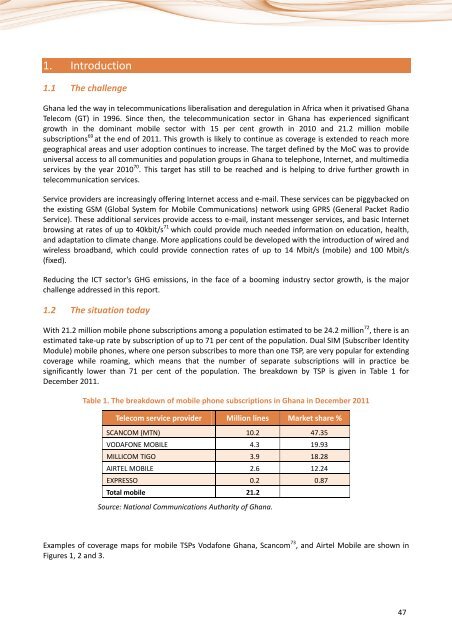Information and communication technologies (ICTs) and ... - ITU
Information and communication technologies (ICTs) and ... - ITU
Information and communication technologies (ICTs) and ... - ITU
Create successful ePaper yourself
Turn your PDF publications into a flip-book with our unique Google optimized e-Paper software.
1. Introduction<br />
1.1 The challenge<br />
Ghana led the way in tele<strong>communication</strong>s liberalisation <strong>and</strong> deregulation in Africa when it privatised Ghana<br />
Telecom (GT) in 1996. Since then, the tele<strong>communication</strong> sector in Ghana has experienced significant<br />
growth in the dominant mobile sector with 15 per cent growth in 2010 <strong>and</strong> 21.2 million mobile<br />
subscriptions 69 at the end of 2011. This growth is likely to continue as coverage is extended to reach more<br />
geographical areas <strong>and</strong> user adoption continues to increase. The target defined by the MoC was to provide<br />
universal access to all communities <strong>and</strong> population groups in Ghana to telephone, Internet, <strong>and</strong> multimedia<br />
services by the year 2010 70 . This target has still to be reached <strong>and</strong> is helping to drive further growth in<br />
tele<strong>communication</strong> services.<br />
Service providers are increasingly offering Internet access <strong>and</strong> e-mail. These services can be piggybacked on<br />
the existing GSM (Global System for Mobile Communications) network using GPRS (General Packet Radio<br />
Service). These additional services provide access to e-mail, instant messenger services, <strong>and</strong> basic Internet<br />
browsing at rates of up to 40kbit/s 71 which could provide much needed information on education, health,<br />
<strong>and</strong> adaptation to climate change. More applications could be developed with the introduction of wired <strong>and</strong><br />
wireless broadb<strong>and</strong>, which could provide connection rates of up to 14 Mbit/s (mobile) <strong>and</strong> 100 Mbit/s<br />
(fixed).<br />
Reducing the ICT sector’s GHG emissions, in the face of a booming industry sector growth, is the major<br />
challenge addressed in this report.<br />
1.2 The situation today<br />
With 21.2 million mobile phone subscriptions among a population estimated to be 24.2 million 72 , there is an<br />
estimated take-up rate by subscription of up to 71 per cent of the population. Dual SIM (Subscriber Identity<br />
Module) mobile phones, where one person subscribes to more than one TSP, are very popular for extending<br />
coverage while roaming, which means that the number of separate subscriptions will in practice be<br />
significantly lower than 71 per cent of the population. The breakdown by TSP is given in Table 1 for<br />
December 2011.<br />
Table 1. The breakdown of mobile phone subscriptions in Ghana in December 2011<br />
Telecom service provider Million lines Market share %<br />
SCANCOM (MTN) 10.2 47.35<br />
VODAFONE MOBILE 4.3 19.93<br />
MILLICOM TIGO 3.9 18.28<br />
AIRTEL MOBILE 2.6 12.24<br />
EXPRESSO 0.2 0.87<br />
Total mobile 21.2<br />
Source: National Communications Authority of Ghana.<br />
Examples of coverage maps for mobile TSPs Vodafone Ghana, Scancom 73 , <strong>and</strong> Airtel Mobile are shown in<br />
Figures 1, 2 <strong>and</strong> 3.<br />
47

















